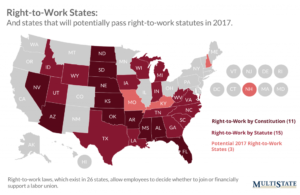Myth: Everyone is better off under “right-to-work” laws.
The so-called “right-to work” is another Orwellian descriptor of legislation whose sole purpose is to destroy workers bargaining power, NOT create jobs. Right-to-work laws give employees in unionized workplaces the right to opt-out of dues. At first, this appears to have some logic because it avoids what political scientists call “tyranny of the majority.” That is, the majority of workers who voted for union representation cannot require those who voted against the union to help pay for it. But, as we all know, workplaces are not democracies and the workers have no voice over wages and working conditions anyway—UNLESS they are organized. What right-to-work does is create a typical free-rider problem in that the union must serve everyone in the bargaining unit, thus non-paying employees receive the same benefits of the union’s efforts as paying employees. Because this situation makes it harder for unions to survive financially, right-to-work states have lower unionization rates—along with the previously demonstrated lower wages and lower benefits.
In 2017, a slight majority (26) of states have right-to-work laws. Right-to-work legislation has recently been passed even in traditionally labor-friendly states such as Indiana (2012), Michigan (2013), and Wisconsin (2015). The right-to-work agenda has been driven by wealthy, powerful corporate interests such as the National Chamber of Commerce and the American Legislative Exchange Council (ALEC), whose interests are almost always opposite those of the public at large. A massive, well-funded effort is underway to pass right-to-work legislation in the remaining worker-friendly states as well as at the national level. Three states were specifically targeted in 2017: Missouri, New Hampshire, and Kentucky:

It should come as no surprise that wages in “worker friendly” states are higher than they are in right-to-work states. However, a study by the National Education Association looked at factors other than wages, because variations in cost-of-living do not always correlate higher wages with financial well-being. The NEA data found that there was no statistical difference between right-to-work and worker-friendly states in rates of employment/unemployment, rates of homeownership, and income gap (inequality). However, there were significant differences in other measures of well-being. Worker-friendly states had a 13.3% higher average per capita GDP ($43,899 versus $38,755), lower poverty rates (11.9% versus 13.9%), higher rates of health insurance coverage (uninsured 13.9% versus 18.6%) and (surprisingly), a higher life expectancy (77.6 years versus 76.7 years, which, though small is nonetheless statistically significant).